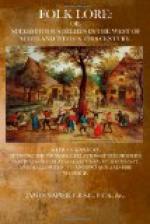for the benefit of souls in purgatory, which was to
be kept by prayers and almsgiving.” It
is easy to perceive that, while in the festival of
Hallowe’en we have the survival of the old Druidical
festival of thank-offering to the sun-god for the
ingathering of the fruits of the earth, we have also
in these two festivals of All Saints and All
Souls the survival of the ancient Ferralia,
or festival to the dead, when offerings were made to
both good and bad spirits, to prevent them haunting
the living; and thus we can account for the prevalence
of the numerous superstitions concerning ghosts and
evil spirits connected with the festival of Hallowe’en.
That these Church feasts were regarded as the substitute
for the Ferralia of Pagan Rome is verified
by Father Meagan in his work on The Mass.
We quote from Jamieson:—“Such was
the devotion of the heathen on this day by offering
sacrifices for the souls in purgatory, by praying
at the graves, and performing processions round the
churchyards with lighted tapers, that they called the
month the month of pardons, indulgences, and absolutions
for souls in purgatory; or, as Plutarch calls it,
the purifying month, or season of purification, because
the living and dead were supposed to be purged and
purified on these occasions from their sins by sacrifices,
flagellations, and other works of mortification.”
Plutarch, I think, must have referred to the month
of February as the purifying month. Father Meagan
has not referred to the change of date made by the
Church. Doubtless the Christian Church, in instituting
these festivals, intended, by divesting them of their
heathen basis, to christianise the people; but, like
Naaman of old, the worshippers, while they worshipped
in the buildings in conformity with the regulations
of their new teachers, yet retained many of their
old Pagan beliefs and ceremonies, and even their teachers
were not thoroughly de-Paganised,—and so
the old and new commingled and crystallized together.
In all the four festivals we have been considering, there survive relics of fire-worship, and through all there runs a similarity of observance and belief; but the special practices are not everywhere joined to the same festival in all localities. In this part of the country, the special observances connected with Hallowe’en were, in other parts of the country, observed in connection with the summer festival. Now, however, we are glad to say, these superstitious ceremonies and beliefs in their old gross forms are fast passing away, or have become so modified that we can scarcely recognise their relations to the old fire-worship.




